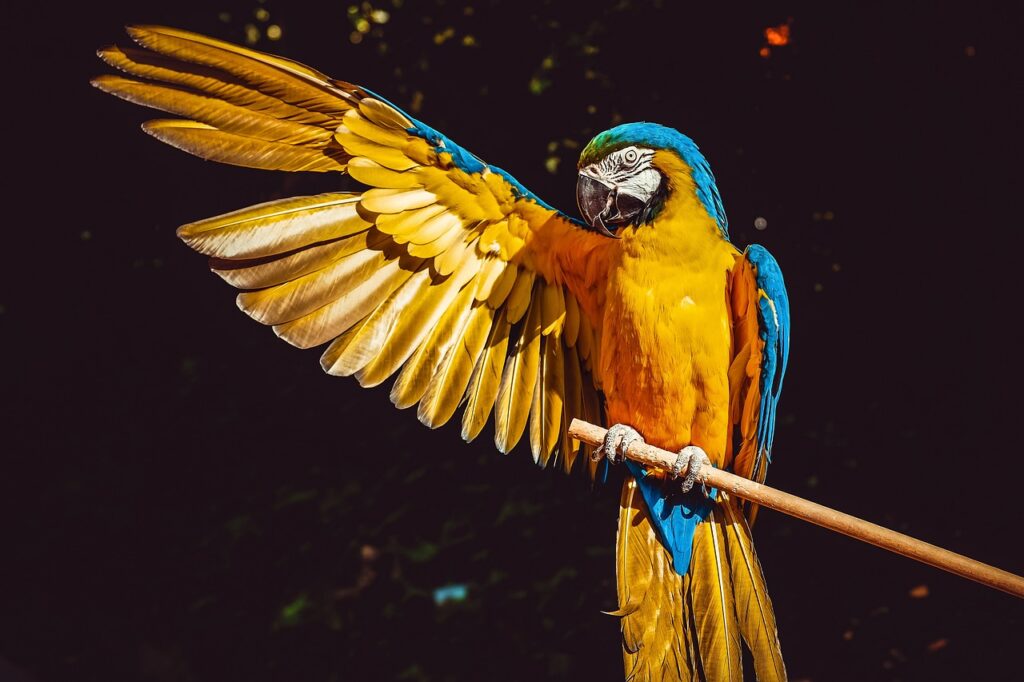When you’re a newbie in the parrot world, picking the right cage might seem daunting. Like picking a house for yourself, but with feathers. Let’s make it easy, shall we?
Understanding Your Parrot’s Needs
Parrots are delightful and intelligent companions, but ensuring their well-being begins with providing them with the right cage. Think of it as their sanctuary, where they eat, play, rest, and occasionally plot world domination (just kidding!). Here’s what you need to consider:
- Space to Move
You wouldn’t like to live in a closet, would you? Similarly, parrots need ample space to spread their wings, play, and jump around. A roomy cage ensures they get the exercise they need to stay healthy and happy. - Enough Room for Toys
Just like toddlers, parrots love their toys. A suitable cage size ensures there’s enough room for swings, bells, and other playthings to keep their intelligent minds engaged. - Safety Concerns
While bigger cages are better in many ways, too much space between bars can let your parrot sneak out or get stuck. Be wary of this, as safety should always be a priority. - Cleanliness
Parrots can be messy eaters. A right-sized cage is easier to clean, making your life simpler. You’ll thank us for this when it’s time for a scrub!
Different Parrot, Different Cage
Parrots come in various sizes and personalities, and their cage requirements reflect this diversity. Here are some recommendations for different parrot species:
- Budgies
These little ones might be small, but they’re mighty active. A cage of 18″x18″x24″ works wonders for their energetic nature. - African Greys
Brainy and beautiful, African Greys need space to think and explore. Aim for a 24″x36″x48″ abode to accommodate their intelligence. - Cockatoos
The drama queens of the parrot world. Give them a stage: 36″x48″x60″. This generous space allows them to show off their flamboyant personalities. - Macaws
The giants need room to stretch their wings. Go big, at least 36″x48″x60″, or even larger, to ensure they have the freedom they require.
Now that you’ve got a grip on the basics let’s explore some more considerations for a parrot’s perfect abode.
Cage Placement in Your Home
Choosing the right cage isn’t just about size and design; where you place it in your home matters too. Here are some tips:
- Stay Away from Windows
While it might seem tempting to place your parrot’s cage by the window, avoid it. Drafts can make your feathery friend sick, and no one wants a sneezing parrot! - Keep Them Central
Parrots are social creatures. Placing their cage in a busy area of your home can keep them happy and chatty. They’ll enjoy being part of the household’s daily activities. - Avoid the Kitchen
As much as your parrot might love to watch you cook, it’s not safe for them. Cooking fumes and parrots don’t mix well, so choose another room to keep them safe. - Quiet Nights
Ensure your parrot’s cage is placed in a quiet spot for night-time. A rested parrot is a happy parrot, and you’ll both appreciate a good night’s sleep!
Materials Matter
Now, let’s talk about the materials used in making parrot cages. The choice of materials plays a significant role in your parrot’s health and safety. Here’s what you need to know:
- Stainless Steel
Stainless steel cages are durable, easy to clean, and rust-free. They are considered the gold standard for parrot cages due to their excellent combination of strength and hygiene. - Wrought Iron
Wrought iron cages are also a popular choice. However, it’s crucial to ensure they are powder-coated to prevent rust. Rust can be harmful to your parrot’s health. - Avoid Lead & Zinc
It’s essential to steer clear of cages made with materials like lead and zinc, as they can be toxic to parrots. These materials are a big no-no when it comes to cage construction. - Wooden Cages
While wooden cages can be aesthetically pleasing, they are not as durable as metal ones. Additionally, your parrot might nibble its way out of a wooden cage, making it a less secure option.
Now that we’ve covered materials, let’s move on to additional features to consider when selecting a cage for your feathered companion.
Additional Features to Consider
When you’re shopping for a parrot cage, it’s not just about the cage itself. Consider these additional features to ensure your parrot’s comfort and well-being:
- Removable Trays
Look for cages with removable trays. These make cleaning a breeze, and maintaining a clean cage is vital for your parrot’s health. - Multiple Doors
Cages with multiple doors are handy for various purposes. You can use them to place toys, food, or even give your parrot a high-five (if they’re in the mood!). - Locks
Parrots are clever creatures, and some of them can be quite the escape artists. Having locks on the cage doors can prevent an unplanned escape and ensure your parrot stays safely inside. - Wheelbase
If you’d like the flexibility to move your parrot’s cage around your home, consider one witha wheelbase. This allows for easy movement, and your parrot can have its little tour around the house.
Setting Up the Interior
Once you have the perfect cage, it’s time to set up the interior to make it a comfortable and engaging space for your parrot. Here’s what you’ll need:
- Perches
Parrots love to perch, and they benefit from having perches of varying sizes and textures. This helps keep their feet healthy and their minds active. Natural wood perches are an excellent choice as they mimic their natural environment. - Water & Food Dishes
Ensure that the water and food dishes are easily accessible and easy to clean. Stainless steel or ceramic dishes are hygienic and safe choices. - Toy Placement
Parrots are playful creatures. When placing toys in the cage, make sure they are not too high or too low. The goal is to create an environment that’s just parrot perfect! - Mirrors
Parrots often enjoy looking at themselves in mirrors. Including a mirror or two in the cage can provide entertainment and mental stimulation for your feathered friend.
Regular Maintenance is Key
Remember, owning a parrot comes with responsibilities, and regular maintenance of their cage is essential. Here are some maintenance tips to keep in mind:
- Daily Cleaning
Make it a habit to wipe down surfaces and change the paper lining in the cage daily. This helps keep the cage clean and free of debris. - Weekly Deep Cleaning
Once a week, set aside time for a thorough cage cleaning. Scrub surfaces, replace bedding, and sanitize dishes to keep germs at bay. - Inspect for Damages
Regularly check the cage for wear and tear. Look for any loose parts, rust, or damage that could pose a safety hazard to your parrot. Safety always comes first! - Rotate the Toys
Keep things fresh and exciting for your feathered friend by rotating their toys regularly. This prevents boredom and ensures they stay mentally engaged.
With these maintenance tips in mind, you’ll be well-equipped to provide a safe and comfortable home for your beloved parrot.
Conclusion
Choosing the right cage for your parrot is a crucial step in providing them with a happy and healthy life. It’s like setting up their very own palace, where they’ll eat, play, sleep, and occasionally engage in some playful antics (world domination is just a parrot’s fantasy, after all!). Remember to consider their size, species, and individual needs when selecting a cage.
By understanding your parrot’s requirements, choosing the right materials, considering additional features, and maintaining their cage with care, you’re not just giving them a place to live—you’re providing them with a safe and enriching environment they can thrive in. Happy parroting!
FAQs
- How often should I replace my parrot’s cage?
- Generally, it’s recommended to replace your parrot’s cage every 5-7 years, or when you notice significant wear and tear. Regular inspections will help you determine when it’s time for an upgrade.
- Can I house two parrots in one cage?
- Housing two parrots in one cage can be possible, depending on their size and temperament. However, always ensure there’s ample space and monitor their behavior closely. Aggression between parrots can be a concern in shared living spaces.
- How can I prevent my parrot from getting bored in its cage?
- Preventing boredom in your parrot’s cage involves offering a variety of toys and regularly rotating them. Introduce new perches, puzzles, and interactive toys to keep their minds engaged. Additionally, provide out-of-cage time for exercise and social interaction.
- Do parrots prefer horizontal or vertical cage bars?
- Parrots generally prefer horizontal bars because they allow for climbing and play. Horizontal bars provide a more natural environment for them, resembling tree branches in the wild.
- What’s the best way to introduce a parrot to a new cage?
- When introducing your parrot to a new cage, place their favorite toys and familiar items inside. Allow them to explore the cage at their own pace. Patience is key, as some parrots may take time to adjust to their new environment.



